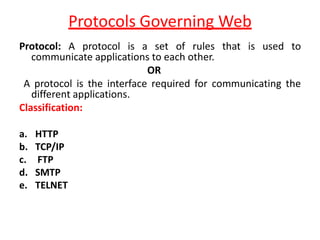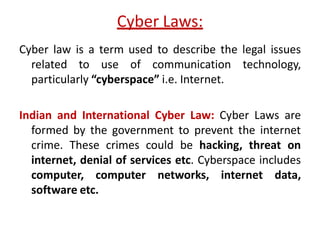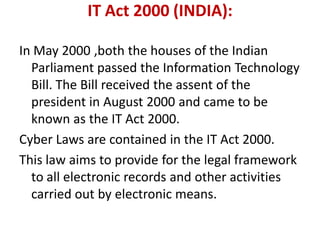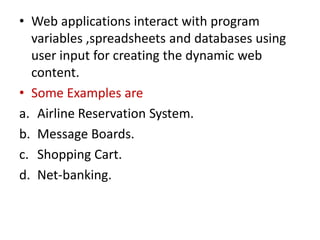Web Technology UPTU UNIT 1
- 1. Web Technology (NCS-504) Prepared By Mr. Abhishek Kesharwani Assistant Professor,UCER Naini,Allahabad
- 2. Unit 1 Introduction • Introduction and Web Development Strategies, History of Web, Protocols governing • Web, Creating Websites for individual and Corporate World, Cyber Laws Web • Applications, Writing Web Projects, web development strategies, Identification of • Objects, Target Users, Web Team, Planning and Process Development, • communication Issues, Quality Assurance and Testing.
- 3. Introduction and Web Development Strategies World Wide Web: The World Wide Web is a system of interlinked hypertext documents accessed via the Internet. Web is a huge collection of pages of information linked to each other around the globe. History of WWW: • WWW is created by Sir Tim Berners Lee in 1989 at CERN in Geneva. • In 1990, the first text only browsers were setup and CERN scientist could access hypertext files and other information at CERN. HTML was based on a subset of the standard generalized markup language (SGML). To transfer HTML document to remote sites a new protocol was devised called HTTP (Hyper Text Transfer Protocol).
- 4. • In the fall of 1991, conference goes around the world started hearing about the promise but sparks still were not flying. • In 1993, there are only about 50 websites world wide. A browser that allowed user to take advantage of the web’s graphical capabilities was developed at the National center for Super Computing application (NCSA). NCSA called the browser Mosaic.
- 5. Protocols Governing Web Protocol: A protocol is a set of rules that is used to communicate applications to each other. OR A protocol is the interface required for communicating the different applications. Classification: a. HTTP b. TCP/IP c. FTP d. SMTP e. TELNET
- 6. HTTP HTTP: HTTP is the primary protocol used to distribute information on the web. Initial HTTP 0.9 does not allow for content typing and does not have provisions for supplying meta- information. Content Typing: To identify the type of data being transferred. Meta Information: It is supplemental data, such as environment variables that identify the client’s computer
- 7. • TCP/IP: It is a set of rules that an application can use to package its information for sending across the networks of networks. • FTP: It is used to transfer the files over networks. FTP uses TCP to create a virtual connection for control information and then creates a separate TCP connection for data transfers. The control connection uses an image of the TELNET protocol to exchange commands and messages between hosts.
- 8. • Simple Mail Transfer Protocol (SMTP) is an Internet standard for electronic mail (e- mail) transmission across Internet Protocol (IP) networks. • Telnet: Telnet lets you remotely log into another system and browse files and directories on that remote system.
- 9. Website A website is simply a collection of interlinked web pages. Classification: A. Corporate Website B. Individual website
- 10. Corporate Website • In this, there is certain no. of persons, who develop their website for a particular organization. • The corporate website are formed when group of people have common interest and objective. • The purpose of this website is to convey the information of organization to all over the world. Individual website It is just like profile management system. In this type of website an individual wants to develop website for h- projection, career growth etc.
- 11. Cyber Laws: Cyber law is a term used to describe the legal issues related to use of communication technology, particularly “cyberspace” i.e. Internet. Indian and International Cyber Law: Cyber Laws are formed by the government to prevent the internet crime. These crimes could be hacking, threat on internet, denial of services etc. Cyberspace includes computer, computer networks, internet data, software etc.
- 12. • Data Protection and Privacy Law: This is due to the nature of the internet and amount of information that may be accessed through it, such legislation is critical to protect the fundamental rights of privacy of an individual. • Electronic and Digital Signature Law: This is required so that uniform and standard procedures are established for authentication of electronics records, EDI, E-Mail. • Computer Crime Law: due to victim of internet threats.
- 13. • Telecommunication Law: Approve and supervise the application of fees and rates charged for telecommunication services in accordance with the provision of the applicable law. • Intellectual Property Law: This includes copyright law, trademark law, semiconductor law and patent law in relation to computer hardware and software.
- 14. IT Act 2000 (INDIA): In May 2000 ,both the houses of the Indian Parliament passed the Information Technology Bill. The Bill received the assent of the president in August 2000 and came to be known as the IT Act 2000. Cyber Laws are contained in the IT Act 2000. This law aims to provide for the legal framework to all electronic records and other activities carried out by electronic means.
- 15. Web Applications • Web application is a kind of application that can be through the web browser over the internet. • Web applications may include simple office software word processors, Google docs, project management, computer-aided design, online spreadsheets, and presentation tools. • Some common scripting languages are used to create web applications such as JSP,ASP and PHP.
- 16. • Web applications interact with program variables ,spreadsheets and databases using user input for creating the dynamic web content. • Some Examples are a. Airline Reservation System. b. Message Boards. c. Shopping Cart. d. Net-banking.
- 17. Writing web Projects Developing web project is a crucial activity and web project development differs from traditional web projects Phases of writing the web projects are A. Write a project mission statement: Write the specific mission statement that you want to do. B. Identify Objectives: i. Specific ii. Measurable iii. Attainable iv. Realistic v. Time limited
- 18. C. Identify your target users: The matter of a website will be determined by the users whom you want to visit the site. This is totally depend upon i. Market research ii. Focus group iii. Understanding the audiences D. Determine the scope: By supporting documents and client’s approval.
- 19. E. Budget: i. Assumption for budgets. ii. Budget categories. iii. Determine hidden costs and tools. F. Planning issues: i. Discuss client’s existing information system. ii. Project team and developing infrastructure. iii. Where the website will place.


















